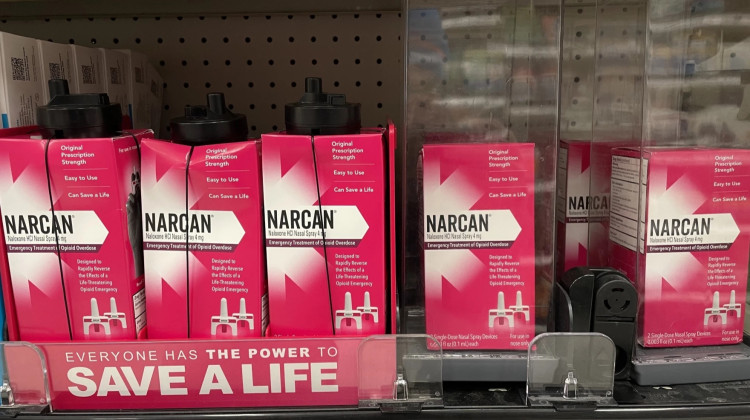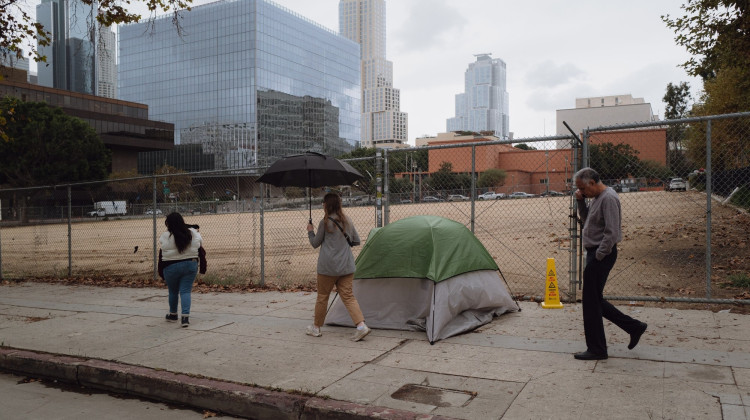
Employees practice hands-on exercises like breaking free if someone grabs them, pulls their hair or even puts them in a headlock. (James Vavrek WFIU/WTIU News)
The indirect effects of the opioid epidemic are far-reaching. The healthcare sector – where opioid medications are often widely-available – is experiencing an uptick in violence.
Last summer a man in Northern Indiana killed a doctor who refused to prescribe an opioid medication to his wife.
Hospitals and doctor’s offices across the country are responding by taking steps to protect their employees and their patients.
Greene County General Hospital
Every month, employees gather in the basement of Greene County General Hospital to learn how to deescalate situations and defend themselves if things get violent.
“The first part of it is actually taking care of yourself and making sure you’re in the right place and the right frame of mind,” says Bryan Woodall, manager of public safety for the hospital.
Woodall started the program in 2014. He says for half the day, participants learn how to talk to people, including how to keep them calm.
“The favorite phrase that everyone loves to say is ‘calm down.’ That absolutely sets people off because a lot of times we don’t know these people,” he says. “It is somebody coming in off the street and needing assistance. It’s an emergency to them. So for us to tell them they need to calm down is aggravating, is a trigger word that sets them off more.”
Instead, the program suggests you should ask questions that unplug the power struggle and show you are listening like, “why are you upset?” or “what do you wish to achieve?”
The second half of the day focuses on physical training.
Employees practice hands-on exercises like breaking free if someone grabs them, pulls their hair or even puts them in a headlock.
The training was originally voluntary but the hospital started requiring it as the opioid crisis reached epidemic proportions and the street value of opioids skyrocketed.
“You know several years back they changed the standards for what you can prescribe and that’s what a lot of these people don’t understand,” Woodall says. “They’ve started putting more restrictions on doctors on what they can prescribe, and I think that’s one of the big areas of what the issue is.”
Health officials say engaging with people who are addicted to opioids concerns all hospitals. it doesn’t matter if it’s a small rural hospital or a larger Level One trauma center like Riley Hospital in Indianapolis.

‘Hospitals are the most violent place to work’
“I think the data says very clearly that hospitals are the most violent place to work except [for] policemen, firemen, those first responders,” says Dr. Elaine Cox, professor of clinical pediatrics and chief medical officer at Rily Hospital.
She says if you look back as recently as the last decade, you would see this hasn’t always been the case.
“There are a lot of things in society I think are magnified by the opioid crisis in America,” Cox says. “I think the drug seeking behavior, some of the violence that we do see when someone cannot get those medications so we’re trying to make it better by clamping down on that.”
Occupational Safety and Health Administration data shows violence against healthcare providers nearly doubled between 2012 and 2014.

(Graphic: Zach Herndon, WFIU/WTIU News)
Cox says hospitals can take extra precautions. Riley Hospital, for example, requires everyone to pass through a body scanner.
But that’s not something small rural hospitals can necessarily afford.
Greene County’s solution is to have at least one-armed security guard on duty at all times.
“Until a couple of years ago, we didn’t have security or any able bodied people that could help us in situations especially at night,” says Jill Raines, director of quality at Green County General Hospital. “And coming from someone who worked nights 18 years it is scary if you’re the only person when someone is out of control here.”
Raines has taken the safety class twice and she says the hospital’s increased focus on security is working. In 2015, the hospital reported 150 incidents where outside law enforcement was called. That dropped to 50 in 2017.
“We do not like to use restraints and we hardly ever do, but it has also decreased by half in those last two years because our staff are better capable of taking care of those escalated situations,” Raines says.
And hospital employees are not the only ones benefiting from the training.
“If we’re afraid to take care of somebody they’re obviously not going to get the best care,” Raines says. “So I do believe that this program has helped increase the confidence and awareness that we as an organization, and our administration and our board wants us to be safe here.”
Raines says they can’t predict when violence will happen, but they can be prepared.
 DONATE
DONATE







 View More Programs
View More Programs


 Support WFYI. We can't do it without you.
Support WFYI. We can't do it without you.